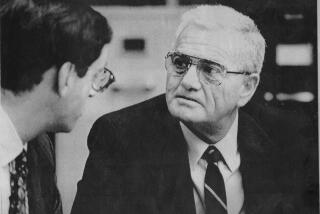Witnesses Challenge Lisker Evidence
- Share via
Two expert witnesses called by government attorneys defending the 1985 murder conviction of Bruce Lisker offered testimony Tuesday undermining key evidence used to convict the San Fernando Valley teenager of killing his mother.
An FBI analyst and a forensic engineer, whose testimony focused on the crime scene evidence, were followed to the witness stand by a drug counselor, who said he once heard Lisker threaten his mother.
Lisker, now 40, was convicted of fatally beating and stabbing his 66-year-old mother, Dorka, in the family’s Sherman Oaks home. He is serving life in prison for the March 10, 1983, slaying.
The testimony came on the fourth day of an evidentiary hearing in federal court on Lisker’s habeas corpus petition to overturn his conviction.
At Lisker’s trial, the prosecutor argued that only Lisker’s bloody shoeprints were found at the crime scene. Sandra Wiersema, an FBI analyst, disputed that claim, testifying that a bloody print in a bathroom at the Lisker residence did not match Lisker’s shoes.
Wiersema said she also found similar spacing between the treads on the mystery print in the bathroom and parallel bruising on the victim’s head. Wiersema said she was unable to determine whether or not the bruising was caused by a shoe.
“I just can’t say one way or the other,” Wiersema said.
Last week, a Los Angeles Police Department criminalist testified that the bruise was a shoe impression that was not made by Lisker’s shoes but was “similar in size and dimension” to the print in the bathroom.
State Deputy Atty. Gen. John Yang, representing the state, also used Tuesday’s hearing to revisit another key element of the prosecution’s case 20 years ago, calling Michael S. Varat, a forensic reconstruction engineer, to testify about sightlines from the rear of the Lisker home.
During Lisker’s trial, prosecutor Phillip Rabichow said that Lisker could not possibly have seen his mother’s body laying on the floor near the front entryway through a dining room window in the backyard, as he told police.
Rabichow told jurors it was Lisker’s “most condemning lie.”
Earlier this year, the now retired deputy district attorney joined Times reporters at the former Lisker home for a reenactment of the crime scene and acknowledged that he was wrong and that Lisker, indeed, may have been able to see his mother from the window. He confirmed his misgivings about the evidence when he testified last week.
Varat, the forensic reconstruction engineer who conducted experiments at the Lisker residence in October, testified Tuesday that the key factor in determining whether the victim would have been visible through the window was figuring out where her body was. But because paramedics took the victim to a hospital before detectives arrived at the scene, her exact location was never pinpointed.
At trial, Rabichow used crime scene photographs depicting bloodstains on a rug to place the victim’s body. When Varat placed the victim in the spot of the bloodstains in his computer-generated reenactment, she was clearly visible from the dining room window.
But when Varat placed the body in a position where a detective testified she might have been -- at least a foot away from the bloodstains -- her head was not visible from the back window.
In his testimony, Varat said the victim’s body would have been visible from several vantage points through the dining room window.
Also at Tuesday’s hearing, Robert D. Breton, another deputy attorney general, called a former counselor from the Palmer Drug Treatment Center in Santa Monica, where both Lisker and his mother had attended meetings in the early 1980s.
James Zeilan said there was “a lot of tension” between the two.
Zeilan, now a teacher living in Texas, said he witnessed one argument that ended with Lisker telling his mother: “I’m going to get you. I hate you.”
Zeilan said Lisker also directed his anger at him, after he told Lisker to leave a meeting because Zeilan believed Lisker was on drugs.
“I’m gonna sic the devil on you,” he recalled Lisker saying.
Zeilan said Lisker’s behavior seemed to correspond with his drug use.
“Bruce was fine when he wasn’t loaded and wasn’t fine when he was,” Zeilan said.
Last week, Lisker’s attorneys called witnesses in an effort to support his claim that he was wrongfully convicted.
One witness -- an Internal Affairs sergeant with the LAPD -- testified that the original detective in the case had conducted a sloppy investigation and appeared to dismiss another possible suspect despite compelling evidence against him. The sergeant also alleged that his supervisor ordered him to shut down his probe after he uncovered evidence that undermined the prosecution’s case against Lisker.
At the conclusion of Tuesday’s testimony, Breton made an unusual request: He asked the judge to order Lisker’s trial attorney, Dennis E. Mulcahy, to talk to lawyers from the attorney general’s office about the case.
Breton said Mulcahy, now a Superior Court commissioner, has refused to speak with him about the case because he believes it would violate his ethical obligations as a judge. But Breton said Mulcahy would talk to him if he were ordered to do so by U.S. Magistrate Judge Ralph Zarefsky, who is presiding over the case.
Breton said he wanted to ask Mulcahy whether Lisker had ever admitted committing the crime.
“Nothing can be more probative than the statements he made to his attorney,” Breton said.
Lisker attorney William Genego objected, arguing that it would be a violation of attorney-client privilege for Mulcahy to divulge anything Lisker told him.
Zarefsky denied Breton’s request, but agreed to consider other scenarios in which Mulcahy might be allowed to testify in the case. Attorneys for both sides were expected to file briefs about the issue.
Testimony is expected to resume today.
More to Read
Sign up for Essential California
The most important California stories and recommendations in your inbox every morning.
You may occasionally receive promotional content from the Los Angeles Times.














